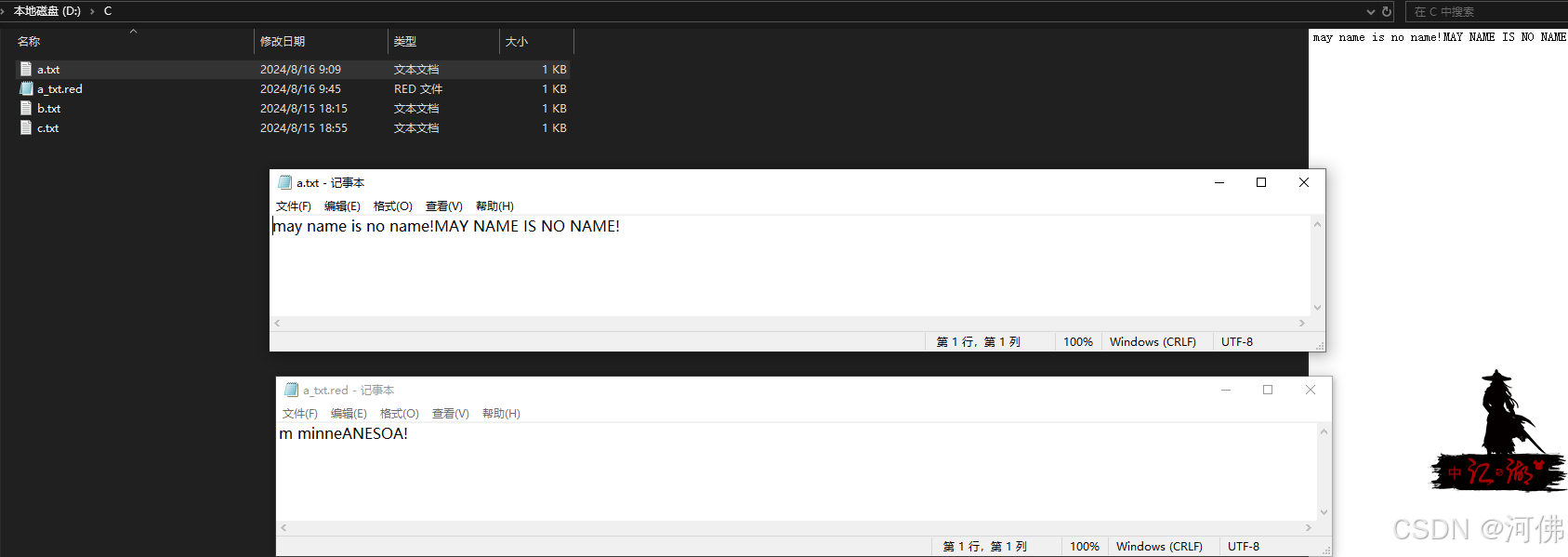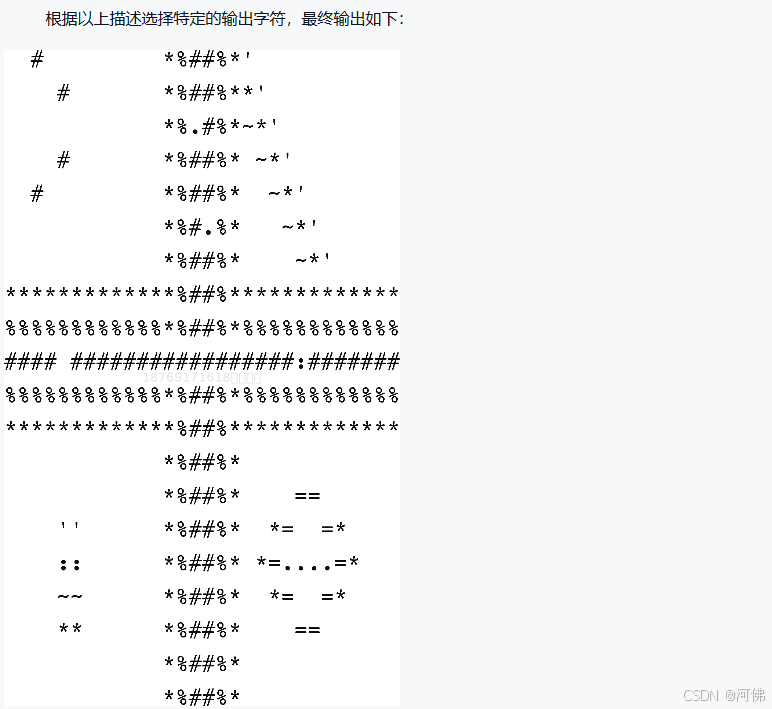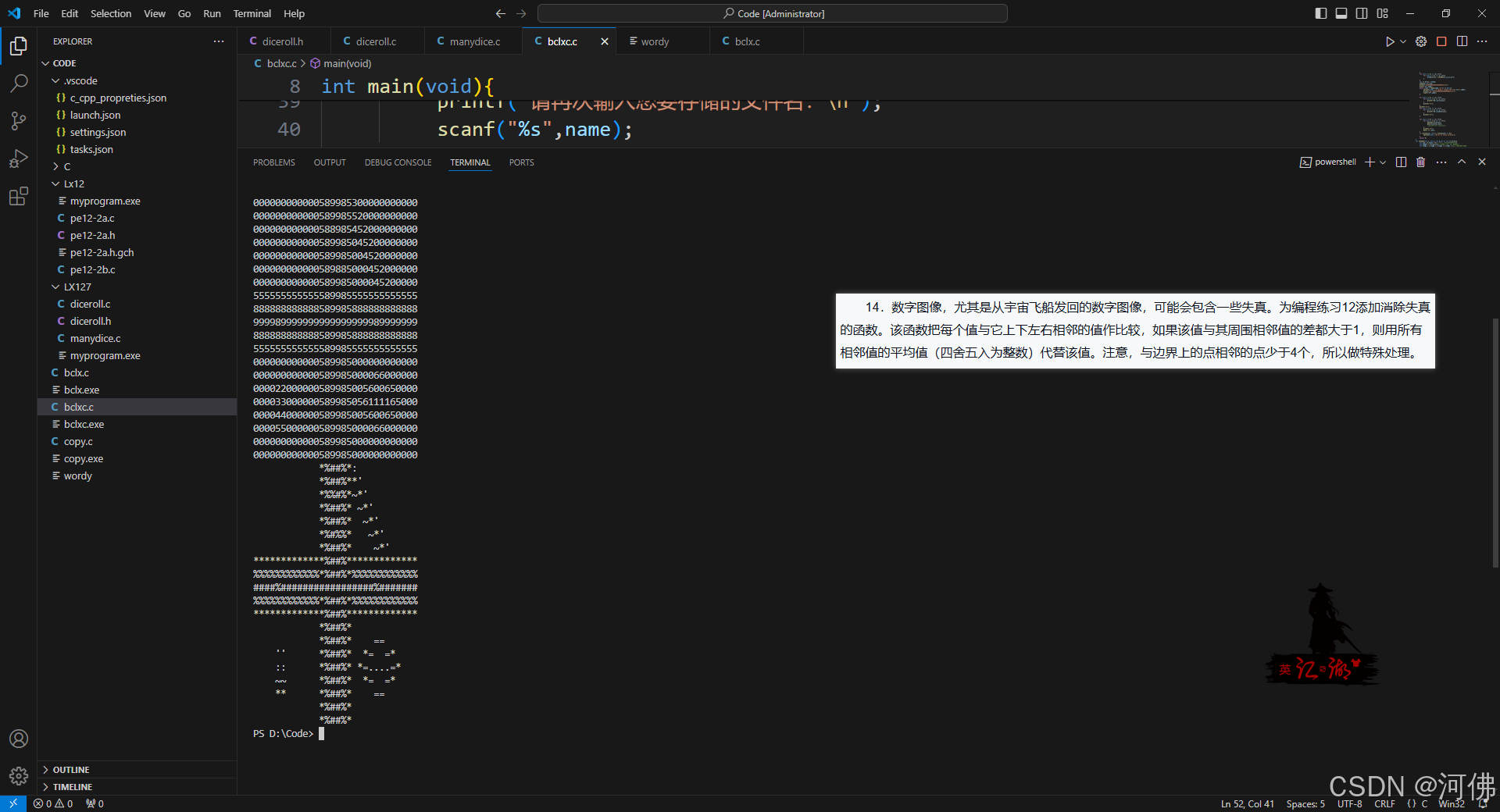第十三章编程练习
对于文件的操作是程序开发过程中必不可少的。首先,来看一下第一题,对13.1程序进行修改,输入文件名,而不是命令行参数。完整程序代码以及运行结果如下:
c
#include<stdio.h>
#include<stdlib.h>
int main(void){
int ch;
FILE * fp;
unsigned long count = 0;
char name[44];
printf("请输入要打开的文件名:\n");
scanf("%s",name);
if ((fp = fopen(name,"r")) == NULL){
printf("Can't open %s\n",name);
exit(EXIT_FAILURE);
}
while ((ch = getc(fp)) != EOF){
putc(ch,stdout);
count++;
}
fclose(fp);
printf("File %s has %lu characters\n",name,count);
return 0;
}
下面,来看一下第二题,编写一个文件拷贝程序,通过命令行获取两个文件名,完整程序代码以及运行结果如下
c
#include<stdio.h>
#include<stdlib.h>
#define SIZE 44
int main(int argc, char * argv[]){
int ch;
FILE * in, * out;
if(argc < 2){
fprintf(stderr,"Usage: %s filename\n",argv[0]);
exit(EXIT_FAILURE);
}
if ((in = fopen(argv[1], "r")) == NULL){
fprintf(stderr,"I couldn't open the file \"%s\"\n",argv[1]);
}
if((out = fopen(argv[2],"w")) == NULL){
fprintf(stderr,"Can't open or create the file \"%s\"\n",argv[2]);
exit(EXIT_FAILURE);
}
while ((ch = getc(in)) != EOF){
putc(ch,out);
}
if (fclose(in) != 0 || fclose(out) != 0){
fprintf(stderr,"Error in close files\n");
}
return 0;
}

下面来看一下第三题,还是写一个文件拷贝程序,但是是让用户输入文件名,然后以该文件名作为原始文件名和输出文件名,然后将文本全部转换成大写。完整程序代码以及运行结果如下:
c
#include<stdio.h>
#include<stdlib.h>
#include<string.h>
#include<ctype.h>
#define SIZE 44
#define PF "D:\\C\\"
#define Y "D:\\C\\a.txt"
int main(){
int ch;
FILE * in, * out;
char name[SIZE];
char pf[SIZE] = PF;
printf("请输入文件名:\n");
scanf("%s",name);
strcat(pf,name);
if ((in = fopen(Y, "r")) == NULL){
fprintf(stderr,"I couldn't open the file \"%s\"\n",Y);
}
if((out = fopen(pf,"w+")) == NULL){
fprintf(stderr,"Can't open or create the file \"%s\"\n",pf);
exit(EXIT_FAILURE);
}
while ((ch = getc(in)) != EOF){
putc(toupper(ch),out);
}
if (fclose(in) != 0 || fclose(out) != 0){
fprintf(stderr,"Error in close files\n");
}
return 0;
}


接下来,来看一下第四题,要求用命令行参数去展示所有的文件,完整程序代码以及运行结果如下:
c
#include<stdio.h>
#include<stdlib.h>
#include<string.h>
#include<ctype.h>
#define SIZE 44
int main(int argc,char * argv[]){
int ch;
FILE * in, * out;
for (int i = 1; i < argc; i++){
if ((in = fopen(argv[i], "r")) == NULL){
fprintf(stderr,"I couldn't open the file \"%s\"\n",argv[i]);
}
while ((ch = getc(in)) != EOF){
putc(ch,stdout);
}
printf("\n");
if (fclose(in) != 0){
fprintf(stderr,"Error in close files\n");
}
}
return 0;
}
下面,我们来看一下第五题的要求,让我们将清单13.5的程序修改为命令行界面。将需要获取的文件名通过命令去赋值即可,完整程序代码以及运行结果如下:
c
/* append.c -- 把文件附加到另一个文件末尾 */
#include <stdio.h>
#include <stdlib.h>
#include <string.h>
#define BUFSIZE 4096
#define SLEN 81
void append(FILE *source, FILE *dest);
char * s_gets(char * st, int n);
int main(int argc, char * argv[]){
FILE *fa, *fs; // fa 指向目标文件,fs 指向源文件
int files = 0; // 附加的文件数量
//char file_app[SLEN]; // 目标文件名
//char file_src[SLEN]; // 源文件名
int ch;
if (argc < 2){
fprintf(stderr,"Usage: %s filename\n",argv[0]);
exit(EXIT_FAILURE);
}
//puts("Enter name of destination file:");
//s_gets(file_app, SLEN);
if ((fa = fopen(argv[1], "a+")) == NULL)
{
fprintf(stderr, "Can't open %s\n", argv[1]);
exit(EXIT_FAILURE);
}
if (setvbuf(fa, NULL, _IOFBF, BUFSIZE) != 0)
{
fputs("Can't create output buffer\n", stderr);
exit(EXIT_FAILURE);
}
puts("Enter name of first source file (empty line to quit):");
int i = 2;
while (i < argc)
{
if (strcmp(argv[2], argv[1]) == 0)
fputs("Can't append file to itself\n", stderr);
else if ((fs = fopen(argv[2], "r")) == NULL)
fprintf(stderr, "Can't open %s\n", argv[2]);
else
{
if (setvbuf(fs, NULL, _IOFBF, BUFSIZE) != 0)
{
fputs("Can't create input buffer\n", stderr);
continue;
}
append(fs, fa);
if (ferror(fs) != 0)
fprintf(stderr, "Error in reading file %s.\n",
argv[2]);
if (ferror(fa) != 0)
fprintf(stderr, "Error in writing file %s.\n",
argv[1]);
fclose(fs);
files++;
printf("File %s appended.\n", argv[1]);
puts("Next file (empty line to quit):");
}
i++;
}
printf("Done appending. %d files appended.\n", files);
rewind(fa);
printf("%s contents:\n", argv[1]);
while ((ch = getc(fa)) != EOF)
putchar(ch);
puts("Done displaying.");
fclose(fa);
return 0;
}
void append(FILE *source, FILE *dest)
{
size_t bytes;
static char temp[BUFSIZE]; // 只分配一次
while ((bytes = fread(temp, sizeof(char), BUFSIZE, source)) > 0)
fwrite(temp, sizeof(char), bytes, dest);
}
char * s_gets(char * st, int n)
{
char * ret_val;
char * find;
ret_val = fgets(st, n, stdin);
if (ret_val)
{
find = strchr(st, '\n'); // 查找换行符
if (find) // 如果地址不是NULL,
*find = '\0'; // 在此处放置一个空字符
else
while (getchar() != '\n')
continue;
}
return ret_val;
}


第五题我是直接用书上的程序清单改的,有些地方提示会比较粗糙,如有需要,请自行修改文本文字。下面看一下第六题的题目要求。将命令行参数修改为提示用户输入所需信息。程序的完整代码以及运行结果如下;
c
// reducto.c --把文件压缩成原来的1/3!
#include <stdio.h>
#include <stdlib.h> // 提供 exit()的原型
#include <string.h> // 提供 strcpy()、strcat()的原型
#define LEN 40
#define PF "D:\\C\\"
int main()
{
FILE *in, *out; // 声明两个指向 FILE 的指针
int ch;
char name[LEN]; // 存储输出文件名
int count = 0;
char inn[LEN]; // 存储输出文件名
char pfin[LEN] = PF; // 存储输出文件名
printf("请输入文件名:\n");
scanf("%s",inn);
strcat(pfin,inn);
// 设置输入
if ((in = fopen(pfin, "r")) == NULL)
{
fprintf(stderr, "I couldn't open the file \"%s\"\n",
pfin);
exit(EXIT_FAILURE);
}
// 设置输出
char innn[LEN];
strcpy(innn,inn);
int i = 0;
while (innn[i] != '\0'){
if(innn[i] == '.'){
innn[i] = '_';
}
i++;
}
strncpy(name, innn, LEN - 5); // 拷贝文件名
name[LEN - 5] = '\0';
strcat(name, ".red"); // 在文件名后添加.red
char pfout[LEN] = PF; // 存储输出文件名
strcat(pfout,name);
if ((out = fopen(pfout, "w")) == NULL)
{ // 以写模式打开文件
fprintf(stderr, "Can't create output file.\n");
exit(3);
}
// 拷贝数据
while ((ch = getc(in)) != EOF)
if (count++ % 3 == 0)
putc(ch, out); // 打印3个字符中的第1个字符
// 收尾工作
if (fclose(in) != 0 || fclose(out) != 0)
fprintf(stderr, "Error in closing files\n");
return 0;
}


接下来,来看一下第七题,打开两个文件,文件名可以用命令行或者输入都可以,然后有两个打印顺序。完整程序代码以及运行结果如下:

样式a结果
c
#include<stdio.h>
#include<stdlib.h>
#include<string.h>
#include<ctype.h>
#define SIZE 44
#define SIZE2 100
int main(int argc,char * argv[]){
char ch[SIZE2];
char ch2[SIZE2];
FILE * in, * out;
if (argc < 2){
fprintf(stderr,"Usage: %s filename\n",argv[0]);
exit(EXIT_FAILURE);
}
if ((in = fopen(argv[1], "r")) == NULL){
fprintf(stderr,"I couldn't open the file \"%s\"\n",argv[1]);
exit(EXIT_FAILURE);
}
if((out = fopen(argv[2],"r")) == NULL){
fprintf(stderr,"Can't open the file \"%s\"\n",argv[2]);
exit(EXIT_FAILURE);
}
int i = 1 ,j = 1;
while (i == 1 || j == 1){
if (fgets(ch,SIZE2,in) != NULL){
fputs(ch,stdout);
}else{
i = 0;
}
if (fgets(ch2,SIZE2,out) != NULL){
fputs(ch2,stdout);
}else{
j = 0;
}
if (i == 0|| j == 0){
printf("\n");
}
}
if (fclose(in) != 0||fclose(out) != 0){//运行的时候忘记关闭out文件流了,后来补充的
fprintf(stderr,"Error in close files\n");
}
return 0;
}
样式b结果:
c
#include<stdio.h>
#include<stdlib.h>
#include<string.h>
#include<ctype.h>
#define SIZE 44
#define SIZE2 100
int main(int argc,char * argv[]){
char ch[SIZE2];
char ch2[SIZE2];
FILE * in, * out;
if (argc < 2){
fprintf(stderr,"Usage: %s filename\n",argv[0]);
exit(EXIT_FAILURE);
}
if ((in = fopen(argv[1], "r")) == NULL){
fprintf(stderr,"I couldn't open the file \"%s\"\n",argv[1]);
exit(EXIT_FAILURE);
}
if((out = fopen(argv[2],"r")) == NULL){
fprintf(stderr,"Can't open the file \"%s\"\n",argv[2]);
exit(EXIT_FAILURE);
}
int i = 1 ,j = 1;
while (i == 1 || j == 1){
int w = 0;
while (ch[w] != '\0'){
ch[w] = '\0';
w++;
}
w = 0;
while (ch2[w] != '\0'){
ch2[w] = '\0';
w++;
}
if (fgets(ch,SIZE2,in) != NULL){
i = 1;
if (j == 1){
char * find = strchr(ch,'\n');
*find = '\0';
}
}else{
i = 0;
}
if (fgets(ch2,SIZE2,out) != NULL && j==1){
strcat(ch,ch2);
}else{
j = 0;
}
fputs(ch,stdout);
}
if (fclose(in) != 0 || fclose(out) != 0){
fprintf(stderr,"Error in close files\n");
}
return 0;
}
接下来,我们来看一下第八题的要求,编写一个可以循环依次计算命令行中文件中指定字符的个数,如果没有文件参数的话,就从标准输入中获取需要计算的内容。完整程序代码以及运行结果如下:
c
#include<stdio.h>
#include<stdlib.h>
#include<string.h>
#include<ctype.h>
#define SIZE 100
int main(int argc, char * argv[]){
FILE * in;
char * c = argv[1];
char arr[SIZE];
int count;
char ch;
if (argc < 2){
fprintf(stderr,"Usage: %s filename\n", argv[0]);
exit(EXIT_FAILURE);
}
if (argc == 2){
printf("请输入您需要回显的内容:\n");
fgets(arr,SIZE,stdin);
fputs(arr,stdout);
count = 0;
for (int i = 0; i < strlen(arr); i++){
if (arr[i] == *c){
count++;
}
}
fprintf(stdout,"字符%c在输入中共出现了%d次!\n",*c,count);
}
for (int i = 2; i < argc; i++){
if ((in = fopen(argv[i],"r")) == NULL){
fprintf(stderr,"I couldn't open the file \"%s\"\n",argv[i]);
continue;
}
count = 0;
while ((ch = getc(in)) != EOF){
if (ch == *c){
count++;
}
}
fprintf(stdout,"字符%c在文件%s中共出现了%d次!\n",*c,argv[i],count);
if (fclose(in) != 0){
fprintf(stderr,"Error in close files\n");
}
}
return 0;
}

接着,我们来看第九题的题目要求,对程序清单13.3进行修改,在前面加一个单词编号,并且每次都在更新编号,完整程序代码以及运行结果如下:
c
#include <stdio.h>
#include <stdlib.h>
#include <string.h>
#define MAX 41
int main(void)
{
FILE *fp;
char words[MAX];
int number = 0;
if ((fp = fopen("wordy", "a+")) == NULL)
{
fprintf(stdout, "Can't open \"wordy\" file.\n");
exit(EXIT_FAILURE);
}
rewind(fp);
while (fgets(words,MAX,fp) != NULL){
number++;
}
rewind(fp);
puts("Enter words to add to the file; press the #");
puts("key at the beginning of a line to terminate.");
while ((fscanf(stdin, "%40s", words) == 1) && (words[0] != '#'))
fprintf(fp, "%d: %s\n", ++number, words);
puts("File contents:");
rewind(fp); /* 返回到文件开始处 */
while (fgets(words,MAX,fp) != NULL){
fputs(words,stdout);
}
puts("Done!");
if (fclose(fp) != 0)
fprintf(stderr, "Error closing file\n");
return 0;
}
下面,我们来看一下第十题的题目要求,需要我们去展示文件位置到第一个换行符之间的内容。完整程序代码以及运行结果如下:
c
#include<stdio.h>
#include<stdlib.h>
#include<string.h>
#define SIZE 44
#define PF "D:\\C\\"
int main(void){
FILE * in;
char name[SIZE];
char pfname[SIZE] = PF;
int number;
char ch;
printf("请输入您要查询的文件名:\n");
scanf("%s",name);
strcat(pfname,name);
if ((in = fopen(pfname,"r")) == NULL){
fprintf(stderr,"I couldn't open the file \"%s\"\n",pfname);
exit(EXIT_FAILURE);
}
printf("请输入您要展示的文件位置:\n");
while (scanf("%d",&number) == 1 && number > 0){
fseek(in,(long)number,SEEK_SET);
while ((ch = getc(in)) != '\n'){
putchar(ch);
}
rewind(in);
printf("\n请再次输入需要展示的文件位置:\n");
}
printf("Done!");
return 0;
}

接下来,便是第十一题的内容了,我们先看一下这道题目的具体要求是什么。接受两个命令行参数,然后一个字符串,一个文件名,打印出文件中包含字符串的所有行的内容,文件中的所有行都不会超过255个字符。完整程序代码以及运行结果如下:
c
#include<stdio.h>
#include<stdlib.h>
#include<string.h>
#define SIZE 255
int main(int argc, char * argv[]){
FILE * in;
char words[SIZE];
if (argc < 2){
fprintf(stderr,"Usage: %s filename\n",argv[0]);
exit(EXIT_FAILURE);
}
if ((in = fopen(argv[2],"r")) == NULL){
fprintf(stderr,"I couldn't open the file \"%s\"\n",argv[2]);
exit(EXIT_FAILURE);
}
while (fgets(words,SIZE,in) != NULL){
if (strstr(words,argv[1])){
fputs(words,stdout);
}
}
if (fclose(in) != 0){
fprintf(stderr,"Error in closing files\n");
}
return 0;
}

下面,我们来看一下第十二题要求我们实现一些什么功能


让我们将数字转换为图像字符,完整程序代码以及运行结果如下:
c
#include<stdio.h>
#include<stdlib.h>
#include<string.h>
#include<ctype.h>
#define NAME "D:\\C\\test.txt"
void zhuan(char (* s)[31], int (* a)[30]);
int main(void){
FILE * in,* out;
int arr[20][30];
char sc[20][31];
char name[44];
if ((in = fopen(NAME,"r")) == NULL){
fprintf(stderr,"I could't open the file %s\n",NAME);
exit(EXIT_FAILURE);
}
int (* a)[30] = arr;
char (* s)[31] = sc;
for (int i = 0; i < 20; i++){
for (int j = 0; j < 30; j++){
fscanf(in,"%d",(*(a+i)+j));
}
}
zhuan(s,a);
printf("请输入您要存储的文件名:\n");
scanf("%s",name);
while ((out = fopen(name,"w+")) == NULL){
fprintf(stderr,"I could't create the file %s\n",name);
printf("请再次输入您要存储的文件名:\n");
scanf("%s",name);
}
for (int i = 0; i < 20; i++){
for (int j = 0; j < 31; j++){
putchar(sc[i][j]);
putc(sc[i][j],out);
//printf("%c",sc[i][j]);
}
printf("\n");
putc('\n',out);
}
if (fclose(in) != 0 || fclose(out) != 0){
fprintf(stderr,"Error in close files\n");
}
return 0;
}
void zhuan(char (* s)[31],int (* a)[30]){
for (int i = 0; i < 20; i++){
for (int j = 0; j < 31; j++){
if (j == 30){
*(*(s+i)+j) = '\0';
continue;
}
switch (*(*(a+i)+j))
{
case 0:
*(*(s+i)+j) = ' ';
break;
case 1:
*(*(s+i)+j) = '.';
break;
case 2:
*(*(s+i)+j) = '\'';
break;
case 3:
*(*(s+i)+j) = ':';
break;
case 4:
*(*(s+i)+j) = '~';
break;
case 5:
*(*(s+i)+j) = '*';
break;
case 6:
*(*(s+i)+j) = '=';
break;
case 7:
*(*(s+i)+j) = '@';
break;
case 8:
*(*(s+i)+j) = '%';
break;
case 9:
*(*(s+i)+j) = '#';
break;
default:
break;
}
}
}
}

接下来,我们来看一下第十三题的要求,让我们用变长数组代替标准数组去修改上一个编程练习。将程序中的数组长度修改为变量值,如有需要,可以根据文件长度去设置变量值,这里暂时不提,完整程序代码以及运行结果如下:
c
#include<stdio.h>
#include<stdlib.h>
#include<string.h>
#include<ctype.h>
#define NAME "D:\\C\\test.txt"
void zhuan(int m, int r, int n, char (* s)[r], int (* a)[n]);
int main(void){
FILE * in,* out;
int m = 20;
int n = 30;
int r = 31;
int arr[m][n];
char sc[m][r];
char name[44];
if ((in = fopen(NAME,"r")) == NULL){
fprintf(stderr,"I could't open the file %s\n",NAME);
exit(EXIT_FAILURE);
}
int (* a)[n] = arr;
char (* s)[r] = sc;
for (int i = 0; i < m; i++){
for (int j = 0; j < n; j++){
fscanf(in,"%d",(*(a+i)+j));
}
}
zhuan(m,r,n,s,a);
printf("请输入您要存储的文件名:\n");
scanf("%s",name);
while ((out = fopen(name,"w+")) == NULL){
fprintf(stderr,"I could't create the file %s\n",name);
printf("请再次输入您要存储的文件名:\n");
scanf("%s",name);
}
for (int i = 0; i < m; i++){
for (int j = 0; j < r; j++){
putchar(sc[i][j]);
putc(sc[i][j],out);
//printf("%c",sc[i][j]);
}
printf("\n");
putc('\n',out);
}
if (fclose(in) != 0 || fclose(out) != 0){
fprintf(stderr,"Error in close files\n");
}
return 0;
}
void zhuan(int m, int r, int n, char (* s)[r],int (* a)[n]){
for (int i = 0; i < m; i++){
for (int j = 0; j < r; j++){
if (j == 30){
*(*(s+i)+j) = '\0';
continue;
}
switch (*(*(a+i)+j))
{
case 0:
*(*(s+i)+j) = ' ';
break;
case 1:
*(*(s+i)+j) = '.';
break;
case 2:
*(*(s+i)+j) = '\'';
break;
case 3:
*(*(s+i)+j) = ':';
break;
case 4:
*(*(s+i)+j) = '~';
break;
case 5:
*(*(s+i)+j) = '*';
break;
case 6:
*(*(s+i)+j) = '=';
break;
case 7:
*(*(s+i)+j) = '@';
break;
case 8:
*(*(s+i)+j) = '%';
break;
case 9:
*(*(s+i)+j) = '#';
break;
default:
break;
}
}
}
}

最后,我们来看一下最后一个问题,在上面的基础上写一个函数去做图像失真处理,四个边上的值需要做一下特殊处理,因为相邻的值只有三个。完整程序代码以及运行结果如下:
c
#include<stdio.h>
#include<stdlib.h>
#include<string.h>
#include<ctype.h>
#define NAME "D:\\C\\test.txt"
void zhuan(int m, int r, int n, char (* s)[r], int (* a)[n]);
int shiZhen(int x, int y, int m,int n, int (* a)[n]);
int main(void){
FILE * in,* out;
int m = 20;
int n = 30;
int r = 31;
int arr[m][n];
int arnew[m][n];
char sc[m][r];
char name[44];
if ((in = fopen(NAME,"r")) == NULL){
fprintf(stderr,"I could't open the file %s\n",NAME);
exit(EXIT_FAILURE);
}
int (* a)[n] = arr;
char (* s)[r] = sc;
for (int i = 0; i < m; i++){
for (int j = 0; j < n; j++){
fscanf(in,"%d",(*(a+i)+j));
}
}
for (int i = 0; i < m; i++){
for (int j = 0; j < n; j++){
arnew[i][j] = shiZhen(i,j,m,n,arr);
}
}
int (* b)[n] = arnew;
zhuan(m,r,n,s,b);
printf("请输入您要存储的文件名:\n");
scanf("%s",name);
while ((out = fopen(name,"w+")) == NULL){
fprintf(stderr,"I could't create the file %s\n",name);
printf("请再次输入您要存储的文件名:\n");
scanf("%s",name);
}
for (int i = 0; i < m; i++){
for (int j = 0; j < n; j++){
printf("%d",arr[i][j]);
}
printf("\n");
}
printf("\n");
for (int i = 0; i < m; i++){
for (int j = 0; j < n; j++){
printf("%d",arnew[i][j]);
}
printf("\n");
}
for (int i = 0; i < m; i++){
for (int j = 0; j < r; j++){
putchar(sc[i][j]);
putc(sc[i][j],out);
//printf("%c",sc[i][j]);
}
printf("\n");
putc('\n',out);
}
if (fclose(in) != 0 || fclose(out) != 0){
fprintf(stderr,"Error in close files\n");
}
return 0;
}
int shiZhen(int x, int y, int m,int n, int (* a)[n]){
int sum = 0,count = 0;//计算总和以及周围数据个数
int number = *(*(a+x)+y);//获取当前下标下原数组的值
int flagu = 1,flagd = 1,flagl = 1,flagr = 1;//是否做失真处理
if (x != 0){//不是最上面一行,就会有上方的值存在
int up = *(*(a+x-1)+y);//获取数据上方的值
if (number-up>1||up-number>1){
flagu = 1;
}else{
flagu = 0;
}
sum += up;
count++;
}
if (x<m-1){//不是最后一行,就会有下侧数据存在
int down = *(*(a+x+1)+y);//获取数据下方的值
if (number-down>1||down-number>1){
flagd = 1;
}else{
flagd = 0;
}
sum += down;
count++;
}
if (y != 0){//不是最左侧一行,就会有左侧数据存在
int left = *(*(a+x)+y-1);//获取数据左侧的值
if ((number-left)>1||(left-number)>1){
flagl = 1;
}else{
flagl = 0;
}
sum += left;
count++;
}
if (y < n-1){//不是最右侧一行,就会有右侧数据存在
int right = *(*(a+x)+y+1);//获取数据右侧的值
if ((number-right)>1||(right-number)>1){
flagr = 1;
}else{
flagr = 0;
}
sum += right;
count++;
}
if (flagu && flagd && flagl && flagr){
return (int)(sum/count);
}else{
return number;
}
}
void zhuan(int m, int r, int n, char (* s)[r],int (* a)[n]){
for (int i = 0; i < m; i++){
for (int j = 0; j < r; j++){
if (j == 30){
*(*(s+i)+j) = '\0';
continue;
}
switch (*(*(a+i)+j))
{
case 0:
*(*(s+i)+j) = ' ';
break;
case 1:
*(*(s+i)+j) = '.';
break;
case 2:
*(*(s+i)+j) = '\'';
break;
case 3:
*(*(s+i)+j) = ':';
break;
case 4:
*(*(s+i)+j) = '~';
break;
case 5:
*(*(s+i)+j) = '*';
break;
case 6:
*(*(s+i)+j) = '=';
break;
case 7:
*(*(s+i)+j) = '@';
break;
case 8:
*(*(s+i)+j) = '%';
break;
case 9:
*(*(s+i)+j) = '#';
break;
default:
break;
}
}
}
}


结果中分别是处理之前以及处理之后的数据内容,为了明显的看一下效果,所以在控制台打印了一下,其实这部分是没必要展示的,如果有需要的话,可以自行删掉。好,以上就是第十三章的编程练习的全部内容,着实废了一些时间,不过秉着磨刀不误砍柴工的想法,慢慢研究慢慢做,总会有效果的。总之,在那发生之前,要多想。